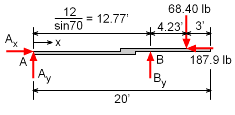| Ch 8. Internal Loads | Multimedia Engineering Statics | ||||||
|
Int. Forces and Moments |
V and M Diagrams I | V and M Diagrams II | V, M, Load Relationships | ||||
| Shear and Moment Diagrams I | Case Intro | Theory | Case Solution | Example |
| Chapter |
| 1. Basics |
| 2. Vectors |
| 3. Forces |
| 4. Moments |
| 5. Rigid Bodies |
| 6. Structures |
| 7. Centroids/Inertia |
| 8. Internal Loads |
| 9. Friction |
| 10. Work & Energy |
| Appendix |
| Basic Math |
| Units |
| Sections |
| eBooks |
| Dynamics |
| Fluids |
| Math |
| Mechanics |
| Statics |
| Thermodynamics |
| ©Kurt Gramoll |
|
|
||
|
|
A free-body diagram of the ladder reveals three unknown reaction forces, Ax, Ay and By. To simplify calculations, the x-y coordinate system is aligned with the ladder. The painter's weight is split into its x and y component, giving Fx = F sinα Fy = F cosα The ladder can be considered as a beam, and oriented in the horizontal position. This will make it easier to plot the shear and moment as a function of x. The free-body diagram for the ladder in the horizontal position is shown at the left. As with most static problem, the reaction forces, Ax, Ay, and By, should be determined first. To find By, sum the moments about the left end to solve for the overhang reaction. ΣMA = -17 (68.40) + By 12.77 = 0 Summing the forces in the x and y directions gives the ground reactions as, ΣFx = Ax - 187.9 = 0 ΣFy = Ay + By - 68.40 = 0 Immediately, there is reason for concern since the reaction at A is negative, which indicates the ladder will lift off the ground. However, assume that the ladder is anchored to the ground and proceed with the problem. Since the ladder has forces acting at three locations, the shear and moment needs to be analyzed in three different sections. The shear and moment may not be continuous across a load or support. |
|
| Section 1 |
||
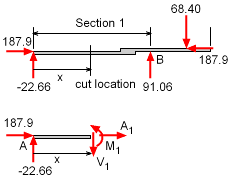 Section 1 |
Each section needs to be cut and analyzed for shear and moment as a function of x from the left edge. The results can then be plotted and the maximum shear and moment can be easily identified. First, cut the beam at the arbitrary point x and then a draw a free-body diagram the left side as shown. Either the left or the right side can be used but generally, the simpler section is used. Next, sum the forces to give, ΣFx = 0 ΣFy = 0 Sum the moments about the cut edge, ΣMcut = 0 It should be noted that these three results are only good for section 1 (0 ≤ x ≤ 12.77 ft). |
|
| Section 2 |
||
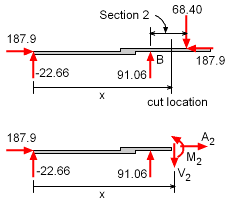 Section 2 |
Section 2 is between the weight of the person and the corner of the roof overhand, point B. Again, cut the ladder at an arbitrary point in section 2 and draw a free-body diagram for the left side of the ladder, as shown. Sum the forces and moments to find repeat the process using the piece to the right of the cut: ΣFx = 0 ΣFy = 0 ΣMcut = 0 These three results are only good for section 1 (12.77 ≤ x ≤ 17 ft). |
|
| Section 3 |
||
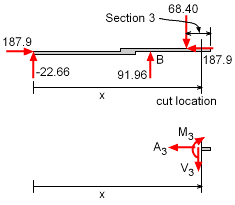 Section 3 |
The final cut is at the far right section of the ladder. For this cut, it is easier to analyzes the right side of the cut. Since there are no loads on this part of the ladder, all forces and moments are zero. A3 = 0 V3 = 0 M3 = 0 These three results are only good for section 1 (17≤ x ≤ 20 ft). |
|
| Shear and Moment Diagrams |
||
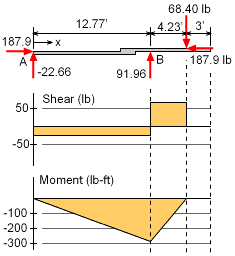 Shear Moment, and Axial Diagrams |
Now that the shear and moment is known for each section of the ladder, the results can be plotted. The resulting graphics are called the shear diagram and moment diagram. Since the same x was used for all three sections, the each equation for each section can be easily plotted as shown at the left. |
|
| Failure in Shear |
||
|
If the ladder were to fail in shear, one would expect it to fail somewhere in section 2 because the shear force, with a magnitude of 68.4 lb, is a maximum in that section. |
||
| Failure in Bending |
||
|
If the ladder were to fail in bending, the failure should occur at the point of contact with the wall, where the bending moment magnitude is a maximum of 290 lb-ft. |
||
Practice Homework and Test problems now available in the 'Eng Statics' mobile app
Includes over 500 free problems with complete detailed solutions.
Available at the Google Play Store and Apple App Store.

